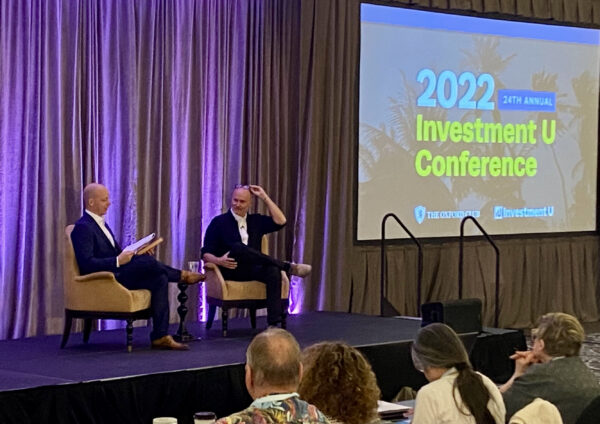The Cautionary Tale of Argentina
- In today’s political discourse, there’s a major focus on wealth and poverty. Are socialist policies the answer to economic inequality?
- Nicholas Vardy examines Argentina’s success (and failure) to find out.
“Those who don’t learn from history are condemned to repeat it.”
– George Santayana, Philosopher
The secret to economic prosperity is no secret at all.
Start with the rule of law, respect for property rights and low taxes. Support them with a stable, commercially minded government… And you have a fail-safe recipe for prosperity.
As recently as the 1960s, the “Asian Tigers” – Singapore, South Korea, Taiwan and Hong Kong – were dirt-poor.
In 1960, Singapore had a per capita GDP of $428. Today, that number stands at $58,248.
The contrast with Argentina could hardly be greater.
Argentina was once rich and prosperous. In 1915, on the eve of World War I, Argentina was among the world’s most prosperous economies. The average Argentine was as wealthy as the average German.
Today, Argentina may be famous for its tango, its savory steaks and its malbec wine. But for investors, Argentina is more famous for being an economic basket case.
And the country’s fall from economic grace has important lessons for U.S. investors.
That’s because you can trace Argentina’s decline directly back to the rise of radical populist ideas.
And these are the same ideas that you see embraced by democratic socialists like Bernie Sanders and Alexandria Ocasio-Cortez.
The Rise and Fall of Argentina
Argentina won its independence from Spain in 1810. But it wasn’t until about 50 years later that the country began to prosper.
Argentina owed its success to two factors.
First, there was the advent of technology. Food canning and commercialization of refrigeration in the 1880s allowed Argentina’s agricultural exports to boom.
Second, there was the British. Argentina was never part of the British empire. But it was the British who built and owned most of Argentina’s railways, ports, slaughterhouses and ships. And they brought their way of doing business with them.
Argentina’s economy continued to prosper into the 20th century, surviving both a military coup in 1930 and the Great Depression.
It was the election of Juan Perón as president in 1946 that set Argentina down the road of economic ruin.
Egged on by his glamorous and ambitious wife Eva (portrayed by Madonna in the 1996 film Evita), Perón introduced left-wing populism to Argentina.
Perón hiked taxes, nationalized industries and redistributed wealth to the poor.
The results were predictable.
Argentina’s economy stagnated. Inflation soared. Capital fled the country. Argentina defaulted on its debts four more times over the next 40 years.
In short, Argentina blew it.
The popularity of free market economics after the fall of communism offered Argentina a second chance.
In 1992, a new president, Carlos Menem, introduced market reforms, privatized major industries and reined in spending.
The reforms worked for a while. But by 2001, Argentina had defaulted yet again.
The new left-wing government led by Néstor Kirchner introduced the familiar mix of populist reforms.
Later, a new right-wing president – Mauricio Macri – duped foreign investors into believing Argentina had changed its economic stripes.
In one of the greatest triumphs of hope over experience in investing, Argentina issued a 100-year(!) bond yielding 7.9% in 2017; it raised $2.75 billion.
Two years later, investors had lost half their money.
In the October 2019 election, the Perónists returned to power. Today, Argentina’s cycle of chaos continues.
A Warning Shot Across the Bow
The doom-and-gloom crowd will tell you that the U.S. is set to go down the path of Argentina.
I disagree.
Politics in the U.S. are far more stable. Today’s left-wing populism is part of the general give-and-take of politics.
German philosopher Georg Hegel wrote about how the “dialectic” drives history. He famously described it as the dynamic of “thesis, antithesis, synthesis.”
Put simply, ideas go from one extreme to another and eventually end up in the middle.
In American political terms, Bush followed Clinton, Obama followed Bush, Trump followed Obama. Each president represented the opposite world view of his predecessor.
The U.S. political system always manages to self-correct. And I’m optimistic that it will do so yet again.
Still, Argentina’s fate reminds us of an important historical lesson: Bad ideas have bad consequences.
We should do our best to avoid them.
[adzerk-get-ad zone="245143" size="4"]About Nicholas Vardy
An accomplished investment advisor and widely recognized expert on quantitative investing, global investing and exchange-traded funds, Nicholas has been a regular commentator on CNN International and Fox Business Network. He has also been cited in The Wall Street Journal, Financial Times, Newsweek, Fox Business News, CBS, MarketWatch, Yahoo Finance and MSN Money Central. Nicholas holds a bachelor’s and a master’s from Stanford University and a J.D. from Harvard Law School. It’s no wonder his groundbreaking content is published regularly in the free daily e-letter Liberty Through Wealth.






